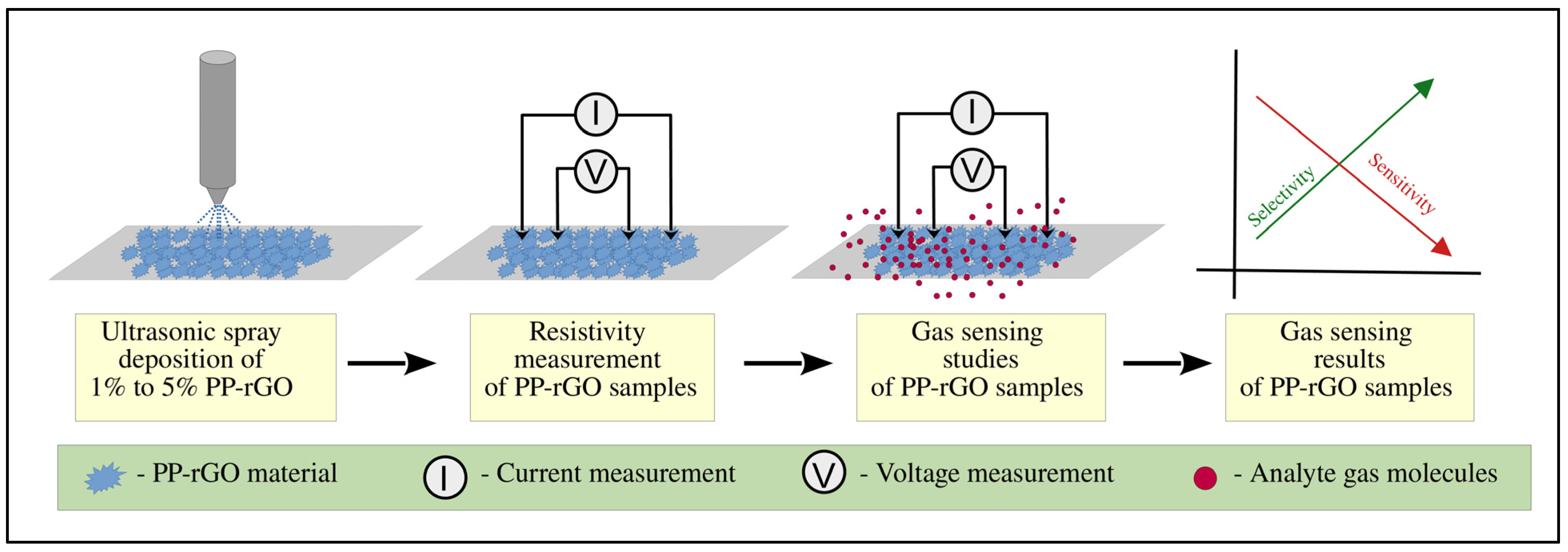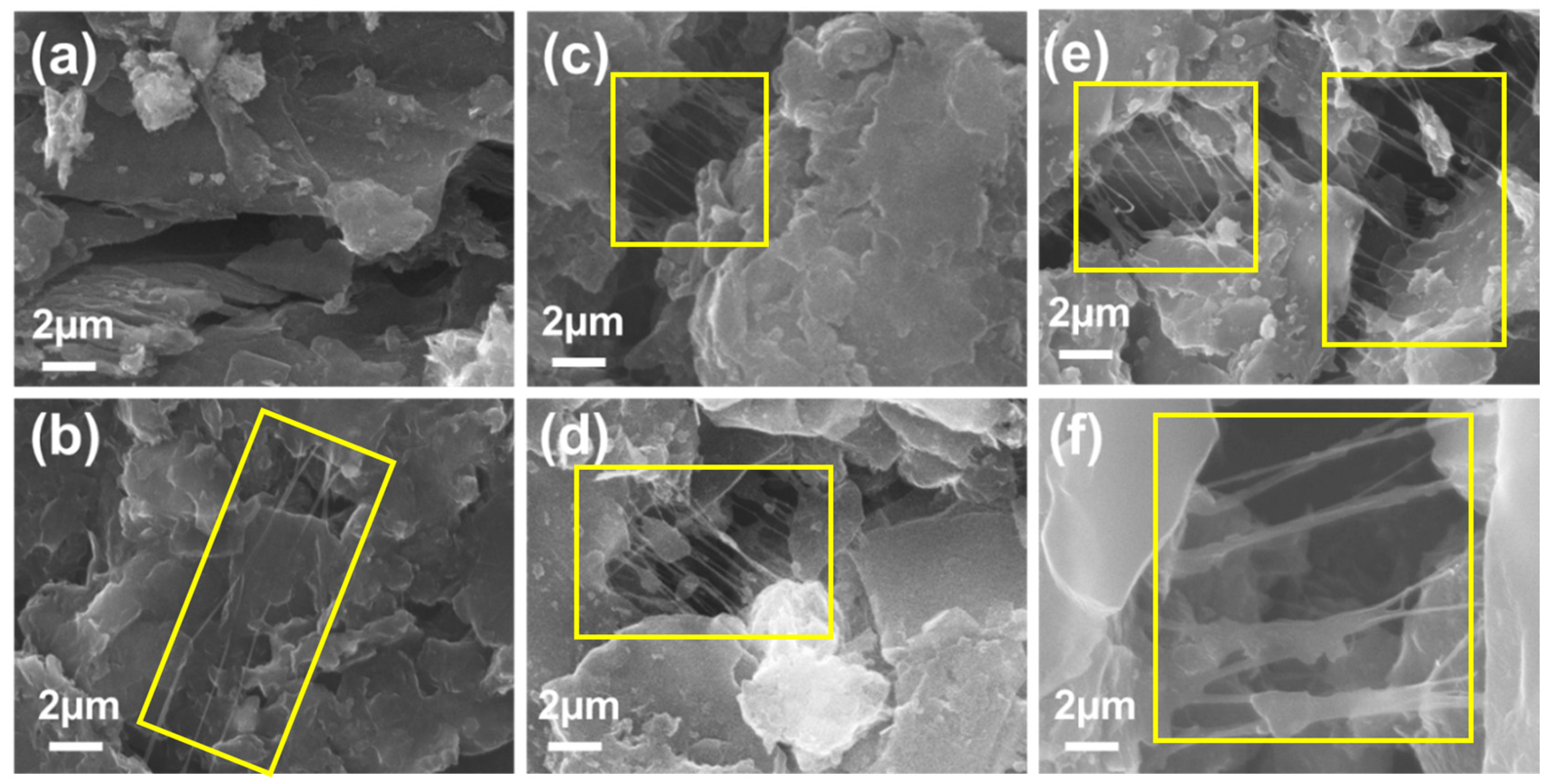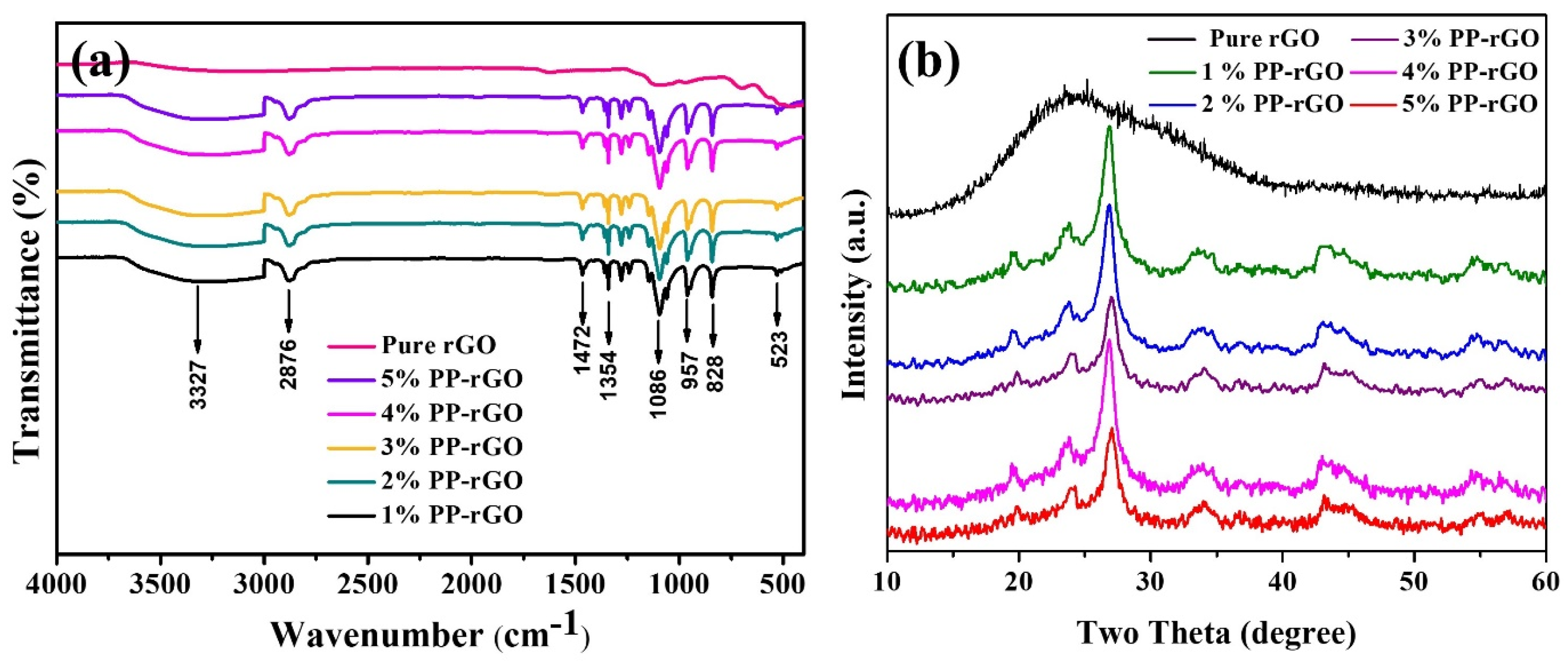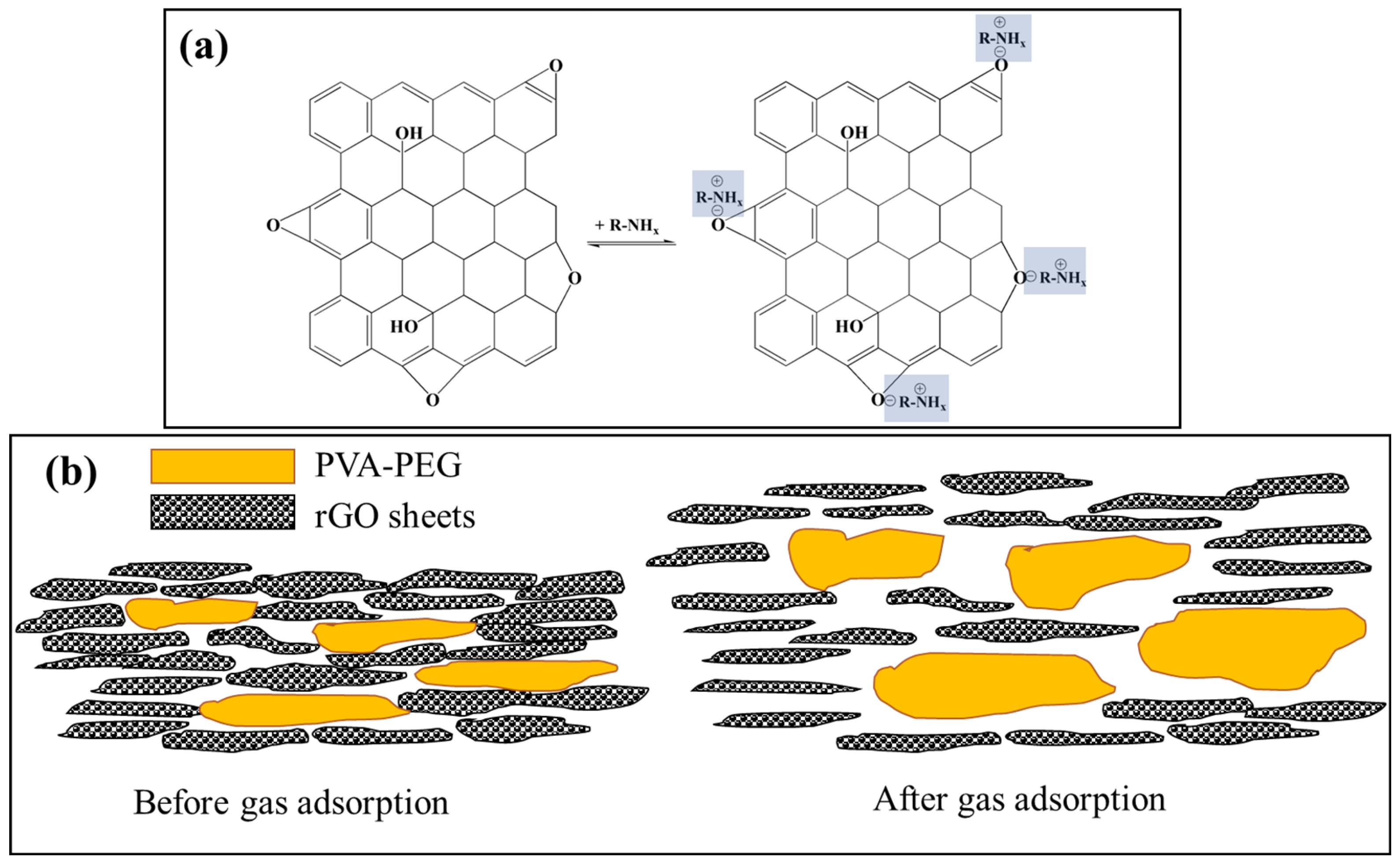Polyvinyl Alcohol–Polyethylene Glycol Embedded Reduced Graphene Oxide Electronic Nose Sensor for Seafood Monitoring
Abstract
1. Introduction
2. Materials and Methods
2.1. Materials
2.2. Synthesis of Polymer–rGO Nanocomposite
2.3. Material Characterization
2.4. Gas-Sensing Studies
3. Results and Discussion
3.1. Scanning Electron Microscopy Studies of rGO and PP-rGO Samples
3.2. FTIR Analysis of rGO and PP-rGO Samples
3.3. XRD Analysis of rGO and PP-rGO Samples
3.4. Gas-Sensing Properties of PP-rGO Samples
3.4.1. Sensitivity and Selectivity of PP-rGO Sensors
3.4.2. Discrimination Test and Calibration Curve for 1% PP-rGO Sensor
3.4.3. Response–Recovery Time, Temperature Stability, Long-Term Stability of the Sensor, and Effect of Humidity on Sensor
3.4.4. Amine Sensing Mechanism for PP-rGO Sensor
4. Conclusions
Supplementary Materials
Author Contributions
Data Availability Statement
Acknowledgments
Conflicts of Interest
References
- Franceschelli, L.; Berardinelli, A.; Dabbou, S.; Ragni, L.; Tartagni, M. Sensing technology for fish freshness and safety: A Review. Sensors 2021, 21, 1373. [Google Scholar] [CrossRef] [PubMed]
- Zambotti, G.; Capuano, R.; Pasqualetti, V.; Soprani, M.; Gobbi, E.; Di Natale, C.; Ponzoni, A. Monitoring fish freshness in real time under realistic conditions through a single metal oxide gas sensor. Sensors 2022, 22, 5888. [Google Scholar] [CrossRef] [PubMed]
- Andre, R.S.; Mercante, L.A.; Facure, M.H.M.; Sanfelice, R.C.; Fugikawa-Santos, L.; Swager, T.M.; Correa, D.S. Recent progress in amine gas sensors for food quality monitoring: Novel architectures for sensing materials and systems. ACS Sensors 2022, 7, 2104–2131. [Google Scholar] [CrossRef] [PubMed]
- Bekhit, A.E.-D.A.; Holman, B.W.; Giteru, S.G.; Hopkins, D.L. Total volatile basic nitrogen (TVB-N) and its role in meat spoilage: A review. Trends Food Sci. Technol. 2021, 109, 280–302. [Google Scholar] [CrossRef]
- Castro, P.; Padrón, J.C.P.; Cansino, M.J.C.; Velázquez, E.S.; De Larriva, R.M. Total volatile base nitrogen and its use to assess freshness in European sea bass stored in ice. Food Control 2006, 17, 245–248. [Google Scholar] [CrossRef]
- Moosavi-Nasab, M.; Khoshnoudi-Nia, S.; Azimifar, Z.; Kamyab, S. Evaluation of the total volatile basic nitrogen (TVB-N) content in fish fillets using hyperspectral imaging coupled with deep learning neural network and meta-analysis. Sci. Rep. 2021, 11, 5094. [Google Scholar] [CrossRef]
- Chang, L.-Y.; Chuang, M.-Y.; Zan, H.-W.; Meng, H.-F.; Lu, C.-J.; Yeh, P.-H.; Chen, J.-N. One-minute fish freshness evaluation by testing the volatile amine gas with an ultrasensitive porous-electrode-capped organic gas sensor system. ACS Sensors 2017, 2, 531–539. [Google Scholar] [CrossRef]
- Allen, M.J.; Tung, V.C.; Kaner, R.B. Honeycomb Carbon: A review of graphene. Chem. Rev. 2010, 110, 132–145. [Google Scholar] [CrossRef]
- Singh, S.A.; More, P.S.; Late, D.J.; Raut, R.W. Investigation of PEG embedded WO3-graphene thin film sensor. Adv. Mater. Proc. 2021, 2, 506–509. [Google Scholar] [CrossRef][Green Version]
- Zhang, S.; Pang, J.; Li, Y.; Ibarlucea, B.; Liu, Y.; Wang, T.; Liu, X.; Peng, S.; Gemming, T.; Cheng, Q.; et al. An effective formaldehyde gas sensor based on oxygen-rich three-dimensional graphene. Nanotechnology 2022, 33, 185702. [Google Scholar] [CrossRef]
- Tian, W.; Liu, X.; Yu, W. Research Progress of Gas Sensor Based on Graphene and Its Derivatives: A Review. Appl. Sci. 2018, 8, 1118. [Google Scholar] [CrossRef]
- Wang, T.; Huang, D.; Yang, Z.; Xu, S.; He, G.; Li, X.; Hu, N.; Yin, G.; He, D.; Zhang, L. A Review on Graphene-Based Gas/Vapor Sensors with Unique Properties and Potential Applications. Nano-Micro Lett. 2015, 8, 95–119. [Google Scholar] [CrossRef]
- Bai, H.; Shi, G. Gas sensors based on conducting polymers. Sensors 2007, 7, 267–307. [Google Scholar] [CrossRef]
- Liu, Z.; Yang, T.; Dong, Y.; Wang, X. A room temperature VOCs gas sensor based on a layer by layer multi-walled carbon nanotubes/poly-ethylene glycol composite. Sensors 2018, 18, 3113. [Google Scholar] [CrossRef] [PubMed]
- Ly, T.N.; Park, S. Highly sensitive ammonia sensor for diagnostic purpose using reduced graphene oxide and conductive polymer. Sci. Rep. 2018, 8, 18030. [Google Scholar] [CrossRef]
- Jetani, G.H.; Rahmani, M.B. Near-room-temperature operating ammonia sensors fabricated using hydrothermally in situ synthesized WS2/rGO nanocomposites. Eur. Phys. J. Plus 2022, 137, 901. [Google Scholar] [CrossRef]
- Jha, R.; Nanda, A.; Bhat, N. Ammonia sensing performance of RGO-based chemiresistive gas sensor decorated with exfoliated MoSe2 Nanosheets. IEEE Sensors J. 2021, 21, 10211–10218. [Google Scholar] [CrossRef]
- Umar, A.; Kumar, R.; More, P.S.; Ibrahim, A.A.; Algadi, H.; Alhamami, M.A.; Baskoutas, S.; Akbar, S. Polyethylene glycol embedded reduced graphene oxide supramolecular assemblies for enhanced room-temperature gas sensors. Environ. Res. 2023, 236, 116793. [Google Scholar] [CrossRef]
- Cuéllar-Herrera, L.; Arce-Estrada, E.M.; Pacheco-Catalán, D.E.; Vivas, L.; Ortiz-Landeros, J.; Jiménez-Lugos, C.; Romero-Serrano, A. Chemical synthesis and electrochemical performance of Hausmannite Mn3O4/rGO composites for supercapacitor applications. Int. J. Electrochem. Sci. 2024, 19, 100737. [Google Scholar] [CrossRef]
- Rajguru, G.M.; Mishra, R.K.; Kharat, P.B.; Khirade, P.P. Structural, microstructural and optical characteristics of rGO-ZnO nanocomposites via hydrothermal approach. Opt. Mater. 2024, 154, 115720. [Google Scholar] [CrossRef]
- Geim, A.K.; Novoselov, K.S. The rise of graphene. Nat. Mater. 2007, 6, 183–191. [Google Scholar] [CrossRef] [PubMed]
- Gul, B.Y.; Pekgenc, E.; Vatanpour, V.; Koyuncu, I. A review of cellulose-based derivatives polymers in fabrication of gas separation membranes: Recent developments and challenges. Carbohydr. Polym. 2023, 321, 121296. [Google Scholar] [CrossRef]
- Zhang, R.; Wang, B.; Wang, X.; Zeng, K.; Guo, C. A fast response NH3 gas sensor based on phthalocyanine-optimized non-covalent hybrid of polypyrrole. Colloids Surf. A Physicochem. Eng. Asp. 2024, 702, 135037. [Google Scholar] [CrossRef]
- Anwer, A.H.; Saadaoui, M.; Mohamed, A.T.; Ahmad, N.; Benamor, A. State-of-the-Art advances and challenges in wearable gas sensors for emerging applications: Innovations and future prospects. Chem. Eng. J. 2024, 502, 157899. [Google Scholar] [CrossRef]
- Li, J.; Zhao, H.; Wang, Y.; Zhou, Y. Approaches for selectivity improvement of conductometric gas sensors: An overview. Sensors Diagn. 2024, 3, 336–353. [Google Scholar] [CrossRef]
- Turlybekuly, A.; Shynybekov, Y.; Soltabayev, B.; Yergaliuly, G.; Mentbayeva, A. The Cross-Sensitivity of Chemiresistive Gas Sensors: Nature, Methods, and Peculiarities: A Systematic Review. ACS Sensors 2024, 9, 6358–6371. [Google Scholar] [CrossRef]
- Jasinski, G. Influence of operation temperature instability on gas sensor performance. In Proceedings of the 2017 21st European Microelectronics and Packaging Conference (EMPC) & Exhibition, Warsaw, Poland, 10–13 September 2017; IEEE: New York, NY, USA, 2017; pp. 1–4. [Google Scholar] [CrossRef]
- Romain, A.; Nicolas, J. Long term stability of metal oxide-based gas sensors for e-nose environmental applications: An overview. Sens. Actuators B Chem. 2010, 146, 502–506. [Google Scholar] [CrossRef]






| Sample | TVB-N | Ammonia | DMA | TMA |
|---|---|---|---|---|
| rGO | 96 ± 8 | 119 ± 11 | 97 ± 12 | 68 ± 5 |
| 1% PP-rGO | 321 ± 15 | 336 ± 12 | 324 ± 10 | 302 ± 12 |
| 2% PP-rGO | 282 ± 12 | 325 ± 13 | 298 ± 8 | 238 ± 15 |
| 3% PP-rGO | 249 ± 17 | 299 ± 13 | 250 ± 14 | 190 ± 14 |
| 4% PP-rGO | 196 ± 16 | 279 ± 14 | 216 ± 10 | 129 ± 12 |
| 5% PP-rGO | 189 ± 18 | 268 ± 15 | 184 ± 14 | 92 ± 10 |
Disclaimer/Publisher’s Note: The statements, opinions and data contained in all publications are solely those of the individual author(s) and contributor(s) and not of MDPI and/or the editor(s). MDPI and/or the editor(s) disclaim responsibility for any injury to people or property resulting from any ideas, methods, instructions or products referred to in the content. |
© 2025 by the authors. Licensee MDPI, Basel, Switzerland. This article is an open access article distributed under the terms and conditions of the Creative Commons Attribution (CC BY) license (https://creativecommons.org/licenses/by/4.0/).
Share and Cite
Nadekar, B.; More, P.S.; Gilani, S.J.; Khollam, Y.B.; Umar, A.; Rana, A.u.H.S.; Palaniswami, M. Polyvinyl Alcohol–Polyethylene Glycol Embedded Reduced Graphene Oxide Electronic Nose Sensor for Seafood Monitoring. Crystals 2025, 15, 405. https://doi.org/10.3390/cryst15050405
Nadekar B, More PS, Gilani SJ, Khollam YB, Umar A, Rana AuHS, Palaniswami M. Polyvinyl Alcohol–Polyethylene Glycol Embedded Reduced Graphene Oxide Electronic Nose Sensor for Seafood Monitoring. Crystals. 2025; 15(5):405. https://doi.org/10.3390/cryst15050405
Chicago/Turabian StyleNadekar, Baliram, Pravin S. More, Sadaf Jamal Gilani, Yogesh B. Khollam, Ahmad Umar, Abu ul Hassan S. Rana, and Marimuthu Palaniswami. 2025. "Polyvinyl Alcohol–Polyethylene Glycol Embedded Reduced Graphene Oxide Electronic Nose Sensor for Seafood Monitoring" Crystals 15, no. 5: 405. https://doi.org/10.3390/cryst15050405
APA StyleNadekar, B., More, P. S., Gilani, S. J., Khollam, Y. B., Umar, A., Rana, A. u. H. S., & Palaniswami, M. (2025). Polyvinyl Alcohol–Polyethylene Glycol Embedded Reduced Graphene Oxide Electronic Nose Sensor for Seafood Monitoring. Crystals, 15(5), 405. https://doi.org/10.3390/cryst15050405








